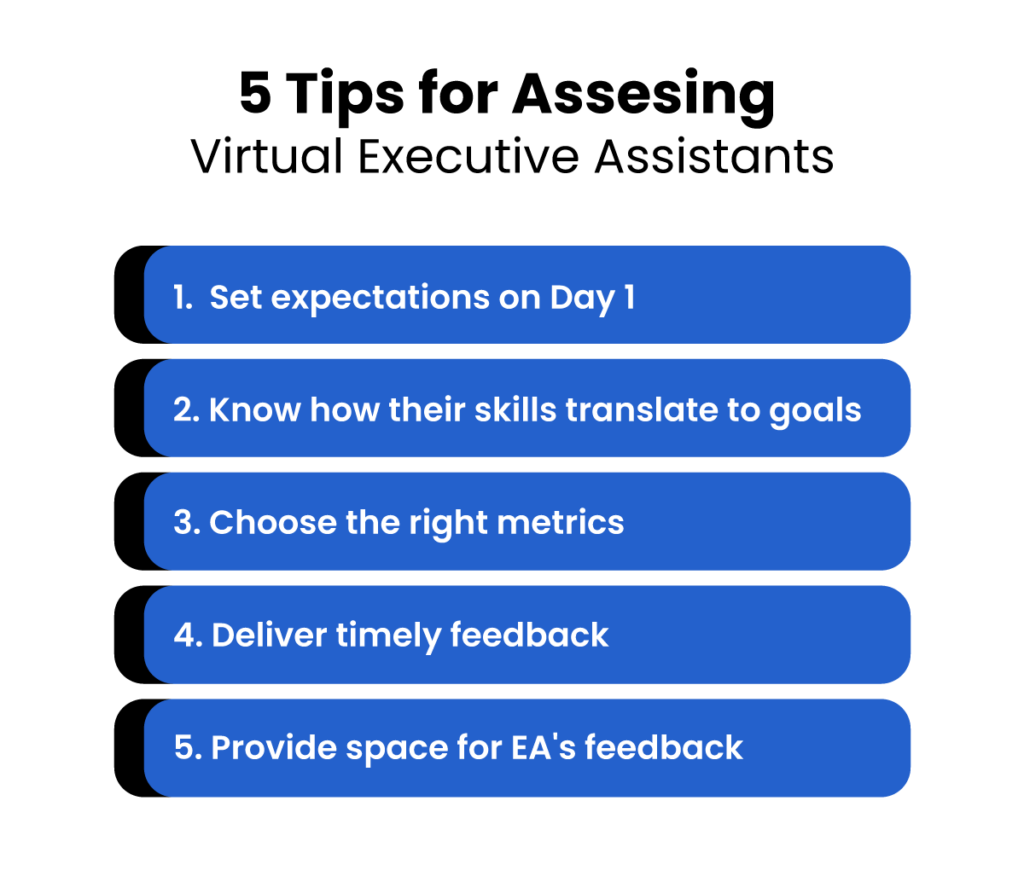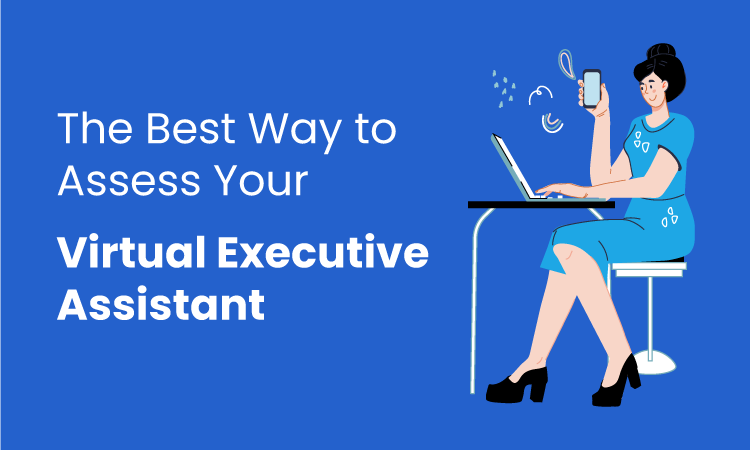Remote assistants are changing the way we work. According to a study on the costs and benefits of agile work, remote workers are 35 to 40% more productive than ones in physical offices. You can reap the benefits of this productivity in multiple ways. Besides getting tasks done faster, you can delegate tedious work to someone trained to handle it. As an employer, you can now hand off time-consuming tasks to a virtual executive assistant.
A virtual EA provides the administrative and executive support you need for your business, at a fraction of the cost of hiring a full-time employee. They also offer benefits that other regular employees cannot provide without the downsides of having someone onsite.
Virtual executive assistants are game changing, so you’d want to employ someone guaranteed to deliver results. If you’re looking for properly vetted virtual assistants, look no further. We provide highly-trained, thoroughly vetted business assistants ready to take on your tasks.
The challenges of assessing a virtual executive assistant
As an employer, you must assess your virtual executive assistant correctly. At the start, though, it can be challenging to evaluate your EA. In most instances, you won’t get to do a trial period with your executive assistant before they are hired. As such, you have no way of knowing whether they’ll fit in with your business culture or if they will deliver results that you expect.
With this in mind, it is important that you find out as much as possible about your potential new employee before you make a decision on whether or not to hire them. It’s equally important to know how to properly evaluate the virtual EA’s performance when they do start working for you. Some of the major challenges an employer can have when assessing a virtual executive assistant are:
Not knowing how to measure their virtual executive assistant’s performance
If you are not sure how to evaluate your virtual executive assistant’s capabilities, you may be in for a challenge. Simply hiring someone isn’t enough. You should be aware of how their skills directly contribute to your business goals. It’s also important to have a way of measuring it and convey all of this to your EA.
Many people hire virtual assistants without fully knowing what tasks they would like their EAs to handle. However, it is important that you clearly define the tasks that you want your virtual executive assistant to perform. This way, you can assess whether or not they will be able to handle the work with ease.
Not using the right metrics for their virtual EA
Often, employers measure their virtual EA’s performance only by the number of tasks they have completed. This is a decent way to gauge their efficiency. However, it is not a one-size-fits-all solution to provide you with the best insights into their performance.
Take time to consider the metrics with which you would like to measure your virtual executive assistant. What unique performance indicators should you use? How can you break these down into criteria for your EA?
Not delivering timely feedback
It is important that you deliver feedback to your virtual executive assistant in a timely manner. Both they and you need to know whether or not they are meeting your expectations. If they’re falling short, they should know, so they can course-correct.
You know best the parameters within which your EA should perform. The sooner you deliver feedback, the sooner you can make changes to your EA’s performance. As a result, you ensure that they give you the results you need. It is important that you establish a proper feedback process before you start with a virtual executive assistant.
Not providing space for the EA to be heard
You must also allow your virtual executive assistant to express their opinions, thoughts, and ideas. Encourage them to speak up if they feel that something is not right. Do not hesitate to ask them if they are able to complete a task on time. Your EA will be eager to help you improve the efficiency of your business.
Similarly, it’s important that they have the space to voice their concerns. EAs should be able to call attention to roadblocks they may be facing. Communication is key to maximizing a workflow, and proper communication is a two-way street. Therefore, it’s crucial that you are always willing to listen to your EA.
Not being on the same page from day 1
It is important that you establish a mutual understanding of what is expected from your virtual executive assistant. Ensure that you are on the same page as far as expectations and requirements are concerned.
Your EA should fully understand the tasks they must perform. They must know the expected turnaround time for each task. It is also important that you understand their limits, such as their preferred working style, availability, and any other constraints that may arise along the way.
Now that we know what the challenges are, it’s time to assessing your virtual executive assistant.

Identify your virtual executive assistant’s KPIs
Solid key performance indicators (KPIs) are crucial in ensuring an individual is meeting the right milestones. So, you need to decide what KPIs you would like your virtual executive assistant to base their workflow on. For example, you can assess the estimated time they need to complete a task. Another KPI could be based around planned hours or milestones, and another could measure how often they make mistakes. You can also monitor their rate of absenteeism, how they interact with the rest of the team, and how they respond to feedback.
Some virtual assistant providers will help you with this matter. If you’re sourcing your virtual EA from Wing, for example, they will also have Customer Success Managers on board. CSMs can work with you to create a detailed breakdown of the KPIs and metrics that you would like to measure your virtual executive assistant on.
Have a routine or process for delivering feedback
This step is crucial in ensuring that you are on the same page with your virtual executive assistant. If you don’t have a feedback process in place, it can be difficult to know whether or not they are doing well. You won’t have a way to determine if they need to change their workflow. Establish a regular feedback process, so you are always able to give them proper feedback on how they’re doing.
Methods for delivering feedback vary from person to person. Some people like to send email, while others prefer to communicate face-to-face—or, in the case of remote and virtual employees, doing it via a video call. So, decide what’s most comfortable for you and your virtual executive assistant.
Set processes for delivering feedback
Furthermore, if you’re delivering your feedback through synchronous meetings or calls, it is important that you have a regular schedule set with your virtual executive assistant. First off, decide whether you want to do this weekly, bi-weekly, or monthly. It’s also good to have a consistent pattern, so that you can establish a regular feedback loop. You can, for example, hold a regular feedback session at the end of every work week.
Additionally, keep in mind the previously mentioned principle of communication: it is a two-way street. Aside from giving them any needed constructive criticism, you should ask them how they are doing and what improvements they would like to make in their work process.
You can also get them to share any issues they are facing. This way, they know to refer back to these meetings whenever they need an update on their performance or an idea on how they can improve their workflow.
Track qualitative indicators of competence
As an employer, you should always keep track of the progress and the performance of your virtual executive assistant. The most important thing is to ensure that you are measuring their overall competence, and not just their output.
Quantitative indicators are things like the number of tasks they have completed, their productivity, and the time it takes them to complete tasks. These metrics are all needed in assessing a virtual EA’s performance, but they can be quite limited in their scope. Therefore, it’s important to also take into account qualitative indicators.
How should managers measure qualitative indicators?
In terms of qualitative values, business owners can assess things such as their EA’s approach to tasks, their interactions with other team members, and their behavior. They can also gauge their EA’s degree of cooperation, whether they show initiative, and their overall attitude towards the tasks they’re assigned.
There are a number of ways to do this. Some people prefer to ask their virtual executive assistant directly what they think of the work they are doing and how they feel about it.
Alternatively, you can use a dashboard or a template to track their performance, and share this with them on a regular basis. You can also ask them to fill out a short questionnaire after every task, so you have a detailed breakdown of their performance.
Tracking qualitative indicators of competence will give you a better understanding of how well your virtual executive assistant is doing, and it will also help you quickly find and solve any roadblocks that they may be facing.
Redirect your virtual executive assistant’s performance
While assessing a virtual executive assistant is important, it is only half of the work. It is also important that you are able to redirect their performance when needed. More specifically, you should be able to spot red flags and subsequently flag them if they are not performing well. If your virtual executive assistant does not have a satisfactory performance rating, there are some things you can do to remedy this.
First, refer to your set KPIs and metrics. This way, you can be sure that you are being fair and objective when assessing their performance.
If you think they seem to be underperforming due to being overwhelmed by the amount of tasks, Reconsider the targets you have set for them. If they seem to still be unfamiliar with their tasks, for example, you may need to provide additional training.
You can also reevaluate their workflow to see if there are ways to improve it, so that they can better handle their workload. This can involve changing the order that they are supposed to do things or maybe switching up some of the software and applications they need to use to do their jobs.
Revisit the onboarding process for your EA
Finally, it is important that you ensure that your virtual executive assistant is given a proper onboarding process. An onboarding process is crucial in ensuring that your virtual executive assistant is given all the tools and resources they need to be successful.
A solid onboarding process involves giving them a rundown of the tools and resources they will need to do their job. You must provide the training they need to know as well. In addition, onboarding should include a checklist of the steps they will need to follow.
So, make sure to regularly revisit the onboarding process, and make any revisions when they are necessary. If your virtual EA needs to use a certain software to do their work, for example, you should make sure they have the ample resources needed to familiarize themselves with it.
It is also important that you make sure that they understand the company’s values and culture. This way, they will be able to know what their role in the company entails and how they should conduct themselves while working there.
Get a vetted virtual executive assistant at Wing
In conclusion, hiring a virtual executive assistant is an important decision for any business. A virtual EA can make or break the growth and workflow for you and your company. Therefore, it is important that you do your research and make sure that you hire the right virtual executive assistant for your business.
Wing provides high-quality VAs at an affordable price, so you can find the perfect fit for your needs without breaking the bank. If you are interested in hiring a VA, set up a call with us and learn more about how Wing can help you!
Alexander Lim is the founder and CEO of Cudy Technologies, a platform aiming to deliver high-quality educational content to students around the world. He is also a freelance writer specializing in tech, startups and marketing. He’s passionate about learning, digital marketing, and the SaaS space, and he likes writing about how startups can market their products and content effectively online.







